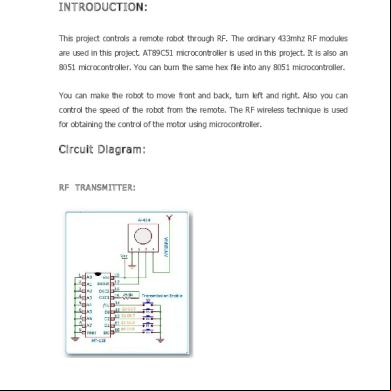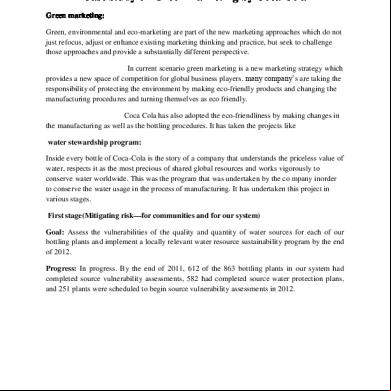Pressure Variation In Static Fluid 2q682g
This document was ed by and they confirmed that they have the permission to share it. If you are author or own the copyright of this book, please report to us by using this report form. Report 3i3n4
Overview 26281t
& View Pressure Variation In Static Fluid as PDF for free.
More details 6y5l6z
- Words: 812
- Pages: 30
CHAPTER 2 PRESSURE IN A STATIC FLUID
Recap: Pressure • The compressive force acting on a surface immersed in a fluid is expressed as a force per unit area and is termed pressure. • Thus, pressure is measured as force per unit area, and its units are N/m2. • It is given the name Pascal (Pa). • Typical atmospheric pressure is about 105 Pa.
Variation of Pressure in Vertical Direction Force balance in vertical direction gives: p zA gzA 0, z p or, g z
Since p does not vary in x and y directions, dp g dz
p p z A z
δz
pδA
ρgδzδA
Variation of Pressure in Horizontal Direction p p x A x
pδA
δx
Horizontal force balance will give
p 0 x
Therefore, pressure does not change in a horizontal plane.
Hydrostatic Pressure Variation dp g dz or, p gz const. p p0 at z 0, so, p p0 gz p0 gh
z
•
h
For water with a free surface exposed to atmosphere
p patm gh 105 (Pa) 103 (kg/m3 ) 9.8 (m/s2 ) h(m); p 105 9.8 103 h
(Pa)
Example What is the pressure at a depth of 10 m in water? What is the pressure at a depth of 10 m in mercury? What is the pressure at a depth of 1 km in water?
A Liquid Maintains its Level •2 •1 h2
h1
•3
•4
p3 = patm +ρgh1 or, p3, gauge = ρgh1 p3 = p4 p4 = patm +ρgh2 or, p4, gauge = ρgh2
A Liquid Maintains its Level
BAROMETER
PRINCIPLE OF BAROMETER
The mercury barometer was first discovered by the Italian Scientist Torricelli in 1643 and has been since then known as the Torricelli barometer.
This barometer works by the level of the mercury in the glass being balanced with the amount of pressure in the atmosphere.
Under normal circumstances, the column of mercury in the glass tube stands at a height of about 30 (29.92) inches (75 centimeters) when measured at sea level.
WHY MERCURY?
Mercury is used because of it's very high density, it is 13.6 times as dense as water. The atmosphere on average holds up about 76cm of mercury in a barometer... A sensible size. If you used water, it would have to be 76 x 13.6 cm at least in height.
Mercury doesn't evaporate very much. A water barometer would constantly need refilling.
CAPILLARITY ACTION
It is the rise or fall of a liquid against gravity in a narrow space such as a thin tube or in porous materials such as paper.
This phenomenon is due to combined effect of cohesion and adhesion of liquid particles.
Capillary Action
Capillary Action
2r r hg 2
h
2 h rg For water (σ = 7.2X10-2 N/m), r = 0.5 mm, the capillary rise is 29 mm
CAPILLARY
Capillary Action
Capillary Action
Figure 1a. The pool of red colored water on this countertop is held together by surface tension and cohesion between the water droplets.
Figure 1b. Capillary action causes the water to "climb" up this paper towel.
PRESSURE MEASUREMENT
MANOMETERS • MECHANICAL GAUGES •
MANOMETERS Simple Manometers • Piezometer • U-tube Manometer
Differential Manometers
PIEZOMETER
LIMITATIONS OF PIEZOMETER 1. Piezometers can measure gauge pressures only. It is not suitable for measuring negative pressures. 2. Piezometers cannot be employed when large pressures in the lighter liquids are to be measured since this would require very long tubes, which cannot be handled conveniently.
U-TUBE MANOMETER
DIFFERENTIAL MANOMETER
A differential manometer is a device that measures the difference in pressure between two places.
Differential manometers are also used to compare the pressure of two different containers. They reveal both which container has greater pressure and how large the difference between the two is.
Inclined Tube Manometer
Inclined-tube manometer is used to measure small pressure differences between two systems .
The advantage of the inclined manometer is that the differential reading scales along the tube can be made large compared to a vertical manometer for a given pressure difference, hence improving the accuracy in reading the scale.
Inclined-Tube Manometer pA = ρgl sinθ Pressure pA θ
l
Reducing Errors in Manometry
Change in density of gauge fluid Density of water changes by 0.75 % as the temperature changes from 100 C to 400 C. Density of mercury changes by 0.5 % as the temperature changes from 100 C to 400 C.
Reducing Errors in Manometry 2 • Capillary rise h rg
• U-tube manometer with both legs of •
same dia is helpful Cleanliness. Degreasing.
Recap: Pressure • The compressive force acting on a surface immersed in a fluid is expressed as a force per unit area and is termed pressure. • Thus, pressure is measured as force per unit area, and its units are N/m2. • It is given the name Pascal (Pa). • Typical atmospheric pressure is about 105 Pa.
Variation of Pressure in Vertical Direction Force balance in vertical direction gives: p zA gzA 0, z p or, g z
Since p does not vary in x and y directions, dp g dz
p p z A z
δz
pδA
ρgδzδA
Variation of Pressure in Horizontal Direction p p x A x
pδA
δx
Horizontal force balance will give
p 0 x
Therefore, pressure does not change in a horizontal plane.
Hydrostatic Pressure Variation dp g dz or, p gz const. p p0 at z 0, so, p p0 gz p0 gh
z
•
h
For water with a free surface exposed to atmosphere
p patm gh 105 (Pa) 103 (kg/m3 ) 9.8 (m/s2 ) h(m); p 105 9.8 103 h
(Pa)
Example What is the pressure at a depth of 10 m in water? What is the pressure at a depth of 10 m in mercury? What is the pressure at a depth of 1 km in water?
A Liquid Maintains its Level •2 •1 h2
h1
•3
•4
p3 = patm +ρgh1 or, p3, gauge = ρgh1 p3 = p4 p4 = patm +ρgh2 or, p4, gauge = ρgh2
A Liquid Maintains its Level
BAROMETER
PRINCIPLE OF BAROMETER
The mercury barometer was first discovered by the Italian Scientist Torricelli in 1643 and has been since then known as the Torricelli barometer.
This barometer works by the level of the mercury in the glass being balanced with the amount of pressure in the atmosphere.
Under normal circumstances, the column of mercury in the glass tube stands at a height of about 30 (29.92) inches (75 centimeters) when measured at sea level.
WHY MERCURY?
Mercury is used because of it's very high density, it is 13.6 times as dense as water. The atmosphere on average holds up about 76cm of mercury in a barometer... A sensible size. If you used water, it would have to be 76 x 13.6 cm at least in height.
Mercury doesn't evaporate very much. A water barometer would constantly need refilling.
CAPILLARITY ACTION
It is the rise or fall of a liquid against gravity in a narrow space such as a thin tube or in porous materials such as paper.
This phenomenon is due to combined effect of cohesion and adhesion of liquid particles.
Capillary Action
Capillary Action
2r r hg 2
h
2 h rg For water (σ = 7.2X10-2 N/m), r = 0.5 mm, the capillary rise is 29 mm
CAPILLARY
Capillary Action
Capillary Action
Figure 1a. The pool of red colored water on this countertop is held together by surface tension and cohesion between the water droplets.
Figure 1b. Capillary action causes the water to "climb" up this paper towel.
PRESSURE MEASUREMENT
MANOMETERS • MECHANICAL GAUGES •
MANOMETERS Simple Manometers • Piezometer • U-tube Manometer
Differential Manometers
PIEZOMETER
LIMITATIONS OF PIEZOMETER 1. Piezometers can measure gauge pressures only. It is not suitable for measuring negative pressures. 2. Piezometers cannot be employed when large pressures in the lighter liquids are to be measured since this would require very long tubes, which cannot be handled conveniently.
U-TUBE MANOMETER
DIFFERENTIAL MANOMETER
A differential manometer is a device that measures the difference in pressure between two places.
Differential manometers are also used to compare the pressure of two different containers. They reveal both which container has greater pressure and how large the difference between the two is.
Inclined Tube Manometer
Inclined-tube manometer is used to measure small pressure differences between two systems .
The advantage of the inclined manometer is that the differential reading scales along the tube can be made large compared to a vertical manometer for a given pressure difference, hence improving the accuracy in reading the scale.
Inclined-Tube Manometer pA = ρgl sinθ Pressure pA θ
l
Reducing Errors in Manometry
Change in density of gauge fluid Density of water changes by 0.75 % as the temperature changes from 100 C to 400 C. Density of mercury changes by 0.5 % as the temperature changes from 100 C to 400 C.
Reducing Errors in Manometry 2 • Capillary rise h rg
• U-tube manometer with both legs of •
same dia is helpful Cleanliness. Degreasing.










